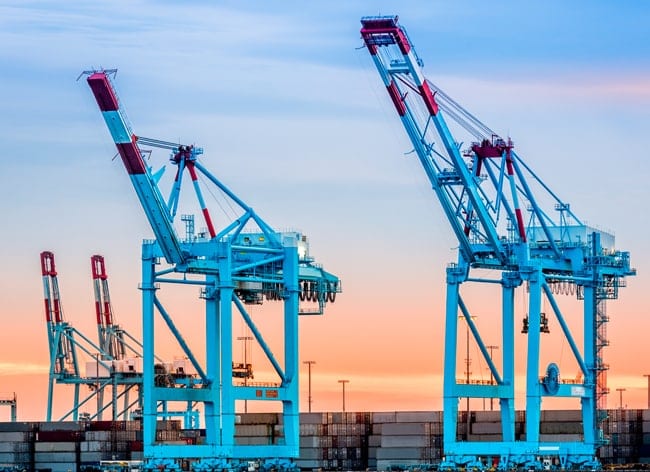7 Striking Stats About Logistics, Global and Local
Back to Blog
Recently, in our order fulfillment review for October, we made brief mention of an intriguing new report from Colliers International on global logistics trends. Titled "From First Mile to Last Mile," - a concept that aligns perfectly with our outlook on business - it chronicles the rapid rise of container shipping and its impact on international trade. The report holds some intriguing stats about logistics on a global scale. Let's take a closer look at some of those statistics and what they mean for our industry.
 6. Alternative US ports are on the rise, as West Coast sees a slide to 49% of US imports. While the decrease in cargo coming in through western US ports is in part due to the labor disputes, it is also part of a wider trend. Volumes dropped from 54 to 49% in Q1, leading many shippers to reconsider the balance of their import strategy. That's why we operate facilities on both coasts, providing the ability to adjust volumes with a fully bicoastal fulfillment solution. 7. Intermodal freight focus sees America's railroad volumes grow 400%. "I've been workin' on the railroad, all the live-long day." So the old song goes, but the glory days of rail freight are far from over. Since 1980, more and more cargo has been winging its way across North America on a freight train, to the tune of a 400% rise over three decades. Intermodal transport solutions have propelled this rise and continue to have supply chain managers looking inwards for many of their operational developments. Those striking stats about logistics in 2015 should be more than enough to set your supply chain brain racing, but we also recommend reading the full report. It's an insightful examination of the logistics industry as it stands today and where global trade is heading in the next few years.
6. Alternative US ports are on the rise, as West Coast sees a slide to 49% of US imports. While the decrease in cargo coming in through western US ports is in part due to the labor disputes, it is also part of a wider trend. Volumes dropped from 54 to 49% in Q1, leading many shippers to reconsider the balance of their import strategy. That's why we operate facilities on both coasts, providing the ability to adjust volumes with a fully bicoastal fulfillment solution. 7. Intermodal freight focus sees America's railroad volumes grow 400%. "I've been workin' on the railroad, all the live-long day." So the old song goes, but the glory days of rail freight are far from over. Since 1980, more and more cargo has been winging its way across North America on a freight train, to the tune of a 400% rise over three decades. Intermodal transport solutions have propelled this rise and continue to have supply chain managers looking inwards for many of their operational developments. Those striking stats about logistics in 2015 should be more than enough to set your supply chain brain racing, but we also recommend reading the full report. It's an insightful examination of the logistics industry as it stands today and where global trade is heading in the next few years.
And if you have questions about your fulfillment needs here and now, we're more than happy to answer them! Contact us today to let us know how we can help.
7 Stats About Logistics on a Global (and Local) Level
Global trade and the channels that drive it are often most effectively communicated in numerical terms. Consider the following seven statistics from the report, which have the potential to reverberate up and down the supply chain: 1. Container shipments have grown by 290% since the turn of the century. Barely stopping to draw breath, even during a major recession, container shipping has grown by an average 8.5% per annum since the year 2000. From 224.8 million TEU that year to 651.1 TEU in 2013, this juggernaut growth continues to demand greater investment in infrastructure - ports, road and rail - and has driven a more integrated supply chain. 2. China's $61.64 billion trade surplus emphasizes a new source of competition. The combined trade surpluses of China and Western Europe almost exactly match the US trade deficit, a subject of much debate as another election season looms. Perhaps it's now time to follow up on the "Made in America" aspirations we wrote about last year? With services like Alibaba's AliExpress aggressively seeking market share in North America, US retailers face increasing competition from the very place that has helped them to establish their dominance, thanks to cheaper labor costs keeping prices low for consumers. 3. Distribution Centers are now twice the size they were a decade ago. You've probably driven past a megacenter DC owner by Walmart or Amazon, but you probably didn't realize even those massive sites were growing in size. Twice the size, in fact, as major retailers look to spaces with more than 1 million square-feet as their "mega DC" standard, up from 500,000 square-feet as the average just ten years ago. 4. "Digital Urban Population" growth outpaces the norm by a ratio of 2:1. Retailers will need an increasingly close and responsive distribution operation to meet the needs of Gens X, Y, and millennials, who will drive what the report calls"urban, online demand." In the US, digital urban population growth has outpaced the overall population increase by almost 200%. 5. Mobile is King, say 81% of CEOs surveyed. Smartphones have preoccupied the public for years now, but it has taken some time for business leaders to catch up. It's understandable, as first ecommerce and now mobile commerce have evolved rapidly, changing the purchase process for many customers. The C-suite is clearly aware of this change and, hopefully, ready to offer consumers the buying experience and pick up process that they want, where they want it. 6. Alternative US ports are on the rise, as West Coast sees a slide to 49% of US imports. While the decrease in cargo coming in through western US ports is in part due to the labor disputes, it is also part of a wider trend. Volumes dropped from 54 to 49% in Q1, leading many shippers to reconsider the balance of their import strategy. That's why we operate facilities on both coasts, providing the ability to adjust volumes with a fully bicoastal fulfillment solution. 7. Intermodal freight focus sees America's railroad volumes grow 400%. "I've been workin' on the railroad, all the live-long day." So the old song goes, but the glory days of rail freight are far from over. Since 1980, more and more cargo has been winging its way across North America on a freight train, to the tune of a 400% rise over three decades. Intermodal transport solutions have propelled this rise and continue to have supply chain managers looking inwards for many of their operational developments. Those striking stats about logistics in 2015 should be more than enough to set your supply chain brain racing, but we also recommend reading the full report. It's an insightful examination of the logistics industry as it stands today and where global trade is heading in the next few years.
6. Alternative US ports are on the rise, as West Coast sees a slide to 49% of US imports. While the decrease in cargo coming in through western US ports is in part due to the labor disputes, it is also part of a wider trend. Volumes dropped from 54 to 49% in Q1, leading many shippers to reconsider the balance of their import strategy. That's why we operate facilities on both coasts, providing the ability to adjust volumes with a fully bicoastal fulfillment solution. 7. Intermodal freight focus sees America's railroad volumes grow 400%. "I've been workin' on the railroad, all the live-long day." So the old song goes, but the glory days of rail freight are far from over. Since 1980, more and more cargo has been winging its way across North America on a freight train, to the tune of a 400% rise over three decades. Intermodal transport solutions have propelled this rise and continue to have supply chain managers looking inwards for many of their operational developments. Those striking stats about logistics in 2015 should be more than enough to set your supply chain brain racing, but we also recommend reading the full report. It's an insightful examination of the logistics industry as it stands today and where global trade is heading in the next few years.And if you have questions about your fulfillment needs here and now, we're more than happy to answer them! Contact us today to let us know how we can help.
